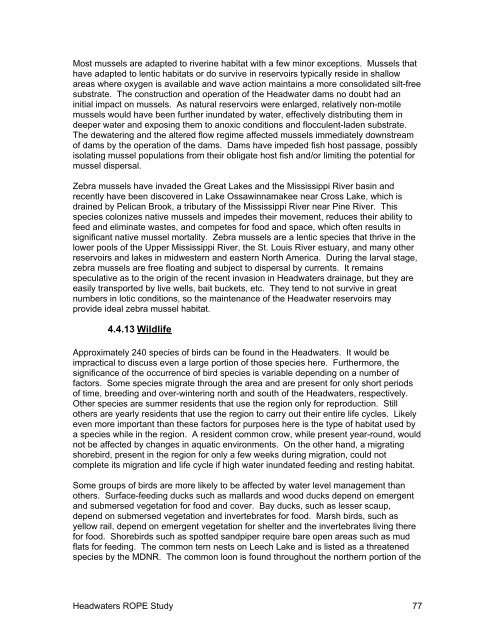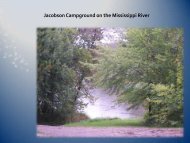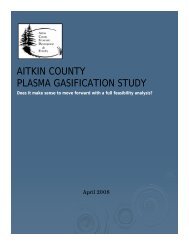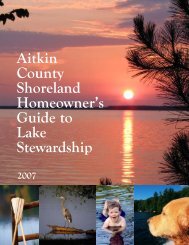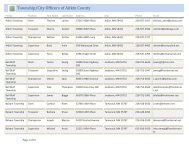Chapter 4: Affected Environment - Aitkin County Government
Chapter 4: Affected Environment - Aitkin County Government
Chapter 4: Affected Environment - Aitkin County Government
- No tags were found...
Create successful ePaper yourself
Turn your PDF publications into a flip-book with our unique Google optimized e-Paper software.
Most mussels are adapted to riverine habitat with a few minor exceptions. Mussels thathave adapted to lentic habitats or do survive in reservoirs typically reside in shallowareas where oxygen is available and wave action maintains a more consolidated silt-freesubstrate. The construction and operation of the Headwater dams no doubt had aninitial impact on mussels. As natural reservoirs were enlarged, relatively non-motilemussels would have been further inundated by water, effectively distributing them indeeper water and exposing them to anoxic conditions and flocculent-laden substrate.The dewatering and the altered flow regime affected mussels immediately downstreamof dams by the operation of the dams. Dams have impeded fish host passage, possiblyisolating mussel populations from their obligate host fish and/or limiting the potential formussel dispersal.Zebra mussels have invaded the Great Lakes and the Mississippi River basin andrecently have been discovered in Lake Ossawinnamakee near Cross Lake, which isdrained by Pelican Brook, a tributary of the Mississippi River near Pine River. Thisspecies colonizes native mussels and impedes their movement, reduces their ability tofeed and eliminate wastes, and competes for food and space, which often results insignificant native mussel mortality. Zebra mussels are a lentic species that thrive in thelower pools of the Upper Mississippi River, the St. Louis River estuary, and many otherreservoirs and lakes in midwestern and eastern North America. During the larval stage,zebra mussels are free floating and subject to dispersal by currents. It remainsspeculative as to the origin of the recent invasion in Headwaters drainage, but they areeasily transported by live wells, bait buckets, etc. They tend to not survive in greatnumbers in lotic conditions, so the maintenance of the Headwater reservoirs mayprovide ideal zebra mussel habitat.4.4.13 WildlifeApproximately 240 species of birds can be found in the Headwaters. It would beimpractical to discuss even a large portion of those species here. Furthermore, thesignificance of the occurrence of bird species is variable depending on a number offactors. Some species migrate through the area and are present for only short periodsof time, breeding and over-wintering north and south of the Headwaters, respectively.Other species are summer residents that use the region only for reproduction. Stillothers are yearly residents that use the region to carry out their entire life cycles. Likelyeven more important than these factors for purposes here is the type of habitat used bya species while in the region. A resident common crow, while present year-round, wouldnot be affected by changes in aquatic environments. On the other hand, a migratingshorebird, present in the region for only a few weeks during migration, could notcomplete its migration and life cycle if high water inundated feeding and resting habitat.Some groups of birds are more likely to be affected by water level management thanothers. Surface-feeding ducks such as mallards and wood ducks depend on emergentand submersed vegetation for food and cover. Bay ducks, such as lesser scaup,depend on submersed vegetation and invertebrates for food. Marsh birds, such asyellow rail, depend on emergent vegetation for shelter and the invertebrates living therefor food. Shorebirds such as spotted sandpiper require bare open areas such as mudflats for feeding. The common tern nests on Leech Lake and is listed as a threatenedspecies by the MDNR. The common loon is found throughout the northern portion of theHeadwaters ROPE Study 77


